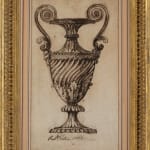Robert Adam (British 1728-92)
12 x 7 in
Further images
Provenance
Collection of John and Eileen HarrisExhibitions
Royal Academy and the V&A, Age of Neoclassicism, 1972Literature
Eileen Harris, The Genius of Robert Adam: His Interiors, 2001, Chapter 10 ‘Osterley Park’ p. 161.
The drawing shows a design for an urn that was to be one of a pair set upon pedestals in the dining room at Osterley Park, Middlesex. The completed urns, made of carved, painted, and gilded wood are attributed to John Linnell (1729–96) and are on display at Osterley Park (National Trust no. NT771750.3).
Harris comments: ‘1766 is the earliest date we have for the dining room. It appears on a design for a vase-shaped cooper which, though uninscribed, is identical to the pair of spiral-fluted mahogany vases made for Osterley by John Linnell and referred to in a bill sent by him to William Drake of Shardeloes on 2 October 1767 for carving ‘two coopers, the tops in the form of vases and large brass handles like Mr. Child’s one lin’d with lead to hold water and the other Top sham and a pot cupboard underneath and painting the same all compleat £30’’. (Eileen Harris, The Genius of Robert Adam: His Interiors, 2001, Chapter 10 ‘Osterley Park’ p. 161 and see note 33 p. 351.)
Sir John Soane bought the majority of Adam’s drawings (nearly 9,000) directly from the Adam family in 1833. It is therefore rare for an example to be available to purchase. This design is an early sketch of a developing concept. It exhibits an energy and enthusiasm that can only be attributed to the architect himself, in contrast to the more technical, finished work of a drawing from his office.
'Preliminary design for a ceiling for the hall, c. 1773' [SM Adam volume 8/33], 'Preliminary design for a chimneypiece and overmantel mirror frame', 1787 [SM Adam volume 24/195], and 'Preliminary design for a girandole for the drawing room', 1775 [SM Adam volume 6/30] are also in the Soane Collection and provide good comparisons for Adam's hand.
Robert Adam became a Fellow of the Royal Society upon his return from Italy in 1761, and as a result, he began his mission to transform English domestic architecture. He replaced Vitruvius' and Palladio's strict grammar of architectural orders with a fresh repertoire of architectural adornment drawn from a wide range of classical sources, from antiquity to the 16th century. The new style became popular almost immediately.
When Adam arrived in Middlesex in 1761, Osterley was a poorly designed Elizabethan pile; by the time he departed in 1778, it had been transformed into a 'palace of palaces... so improved and enriched that all the Percies and Seymours of Sion must die of envy' [op. cit. Harris, Eileen, 2001]. When banker Sir Thomas Gresham bought the manor of Osterley in 1562, the first structure was a manor house built for him in the 1570s. In the late 1600s, the estate belonged to Nicholas Barbon, a developer who mortgaged it to Child's Bank before passing away in 1698. By the early 1710s, Sir Francis Child, the founder of Child's Bank, had acquired the estate due to mortgage default. The property was remodelled in 1761 by Sir Francis's grandsons, Francis and Robert, who appointed Robert Adam.






